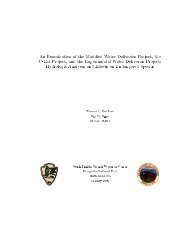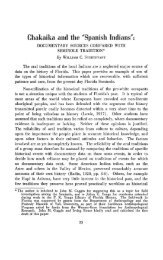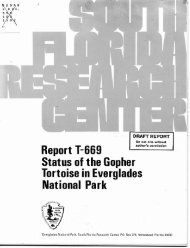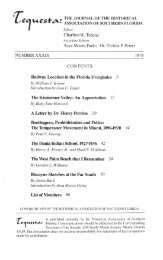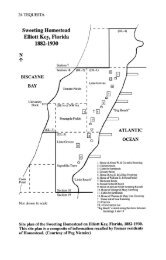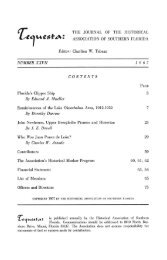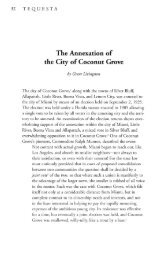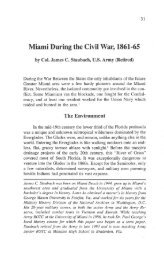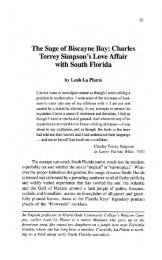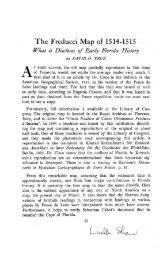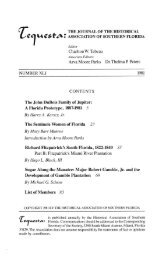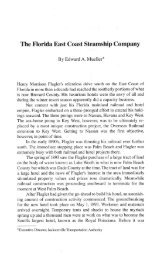Yamato Colony: A Japanese Presence in South Florida - FIU Digital ...
Yamato Colony: A Japanese Presence in South Florida - FIU Digital ...
Yamato Colony: A Japanese Presence in South Florida - FIU Digital ...
Create successful ePaper yourself
Turn your PDF publications into a flip-book with our unique Google optimized e-Paper software.
<strong>Yamato</strong> <strong>Colony</strong>:<br />
A <strong>Japanese</strong> <strong>Presence</strong> <strong>in</strong> <strong>South</strong> <strong>Florida</strong><br />
By George E. Pozzetta* and Harry A. Kersey, Jr. *<br />
<strong>Florida</strong> has been most often identified <strong>in</strong> the popular m<strong>in</strong>d with oranges,<br />
sunsh<strong>in</strong>e, and tourism. What is perhaps less well known is the fact that<br />
land development and settlement have also been prom<strong>in</strong>ent characteristics<br />
of the state's colorful history. Land promoters and colonizers of<br />
every stripe competed with each other throughout <strong>Florida</strong>'s past <strong>in</strong> their<br />
efforts to dispose of millions of acres of land. Particularly at the turn of<br />
the present century was the pen<strong>in</strong>sula state the scene of <strong>in</strong>credible<br />
diverse and widespread settlement activities. No coloniz<strong>in</strong>g venture<br />
dur<strong>in</strong>g this period, however, was more ambitiously conceived or vigorously<br />
carried out than a 1904 effort to establish a <strong>Japanese</strong> colony <strong>in</strong><br />
south <strong>Florida</strong>.<br />
The impetus to br<strong>in</strong>g <strong>Japanese</strong> settlers to <strong>Florida</strong> was supplied by<br />
Joseph Sakai, an American educated expatriate who dreamed of establish<strong>in</strong>g<br />
agricultural colonies composed of his countrymen throughout<br />
the state. These centers were to serve not only as outlets for ambitious<br />
<strong>Japanese</strong> who were <strong>in</strong>creas<strong>in</strong>gly feel<strong>in</strong>g the pressures of Japan's grow<strong>in</strong>g<br />
population and limited resources, but also were to provide, if successful,<br />
profit and <strong>in</strong>vestment opportunities for Sakai himself. To br<strong>in</strong>g about<br />
these objectives the energetic developer arrived <strong>in</strong> Jacksonville <strong>in</strong> late<br />
November; 1903, bear<strong>in</strong>g letters of <strong>in</strong>troduction from the dean of the<br />
New York School of F<strong>in</strong>ance and other prom<strong>in</strong>ent persons. He presented<br />
the Jacksonville Board of Trade with a scheme to import forty or fifty<br />
<strong>Japanese</strong> families and establish them <strong>in</strong> small colonies -of ten or so<br />
apiece. These groups were to engage <strong>in</strong> agricultural experiments, emphasiz<strong>in</strong>g<br />
the growth of silk, tea, tobacco, p<strong>in</strong>eapples and rice. Sakai<br />
*Dr. Pozzetta is an Associate Professor of Social Sciences and History at the<br />
University of <strong>Florida</strong>.<br />
**Dr. Kersey is Professor of Education at <strong>Florida</strong> Atlantic University.
<strong>Yamato</strong> <strong>Colony</strong> 67<br />
further announced that he <strong>in</strong>tended to purchase a total of 67,000 acres of<br />
land for these projects. 1<br />
Floridians gave an enthusiastic welcome to Mr. Sakai and pledged<br />
substantial help for those to follow. Sakai received an official endorsement<br />
from Governor William Jenn<strong>in</strong>gs, and, <strong>in</strong> a subsequent trip to<br />
Wash<strong>in</strong>gton, he obta<strong>in</strong>ed similar encouragement from the U.S. Commissioner<br />
of Immigration and the Secretary of Agriculture. More substantially,<br />
the <strong>Florida</strong> East Coast Railway, along with several private <strong>in</strong>vestors,<br />
donated one thousand acres of land <strong>in</strong> Lee, Leon, and Manatee<br />
counties, with promises of more to come. One such speculator, retired<br />
Professor E. Warren Clark of Tallahassee, predicted that the <strong>Japanese</strong><br />
would "revolutionize farm<strong>in</strong>g <strong>in</strong> this state." 2<br />
Sakai returned to Japan <strong>in</strong> January of 1904 to recruit the necessary<br />
agriculturists and make arrangements for passage. In this task he was<br />
aided by Count Okadaira, a member of the royal household. Like Sakai,<br />
the Count was a graduate of an American college and had a deep <strong>in</strong>terest<br />
<strong>in</strong> efforts to colonize <strong>Japanese</strong> farmers. 3 The Russo-<strong>Japanese</strong> War caused<br />
some unavoidable delays, but on November 14, 1904, an advance guard<br />
of five hardy souls landed <strong>in</strong> San Francisco from the decks of the steamer<br />
Manchuria and announced their <strong>in</strong>tentions of proceed<strong>in</strong>g to <strong>Florida</strong>.<br />
After review<strong>in</strong>g several possible sites for his first settlement, Sakai<br />
chose a section of land just north of present day Boca Raton, near the<br />
Joseph Sakai, founder of <strong>Yamato</strong><br />
<strong>Colony</strong>. Orig<strong>in</strong>al picture <strong>in</strong> possession of<br />
authors.
68 TEQUESTA<br />
tracks of the <strong>Florida</strong> East Coast Railway. 5 The <strong>in</strong>habitants christened<br />
their new home "<strong>Yamato</strong>," the ancient name for Japan itself. Sakai<br />
cont<strong>in</strong>ued to talk of locat<strong>in</strong>g additional colonies elsewhere <strong>in</strong> the state,<br />
mention<strong>in</strong>g frequently a site near Delray to the north, but no other<br />
settlement was made. The settlers planted heavily <strong>in</strong> p<strong>in</strong>eapples for the<br />
first season and devoted lesser acreages to experiments with other crops<br />
such as silk and tea.<br />
Initial farm<strong>in</strong>g work was slow and exceed<strong>in</strong>gly difficult. Virg<strong>in</strong><br />
land had to be cleared laboriously by hand with grubb<strong>in</strong>g hoe, rake and<br />
shovel - an acre or so per season was all that even the most work<strong>in</strong>g<br />
settler could reasonably expect to f<strong>in</strong>ish. The tropical climate added to<br />
the hardships that the <strong>Japanese</strong> endured, and many immigrants found<br />
their first experience with <strong>Florida</strong> to be a severe disappo<strong>in</strong>tment. Seventy<br />
years later, one of the orig<strong>in</strong>al residents still spoke of the ra<strong>in</strong> that<br />
each season flooded fields and ru<strong>in</strong>ed precious crops, of the mosquitoes<br />
and flies that forced everyone to wear head-nets before go<strong>in</strong>g out dur<strong>in</strong>g<br />
the summer months, and, above all, of the heat that bore down upon<br />
everyone as they worked with heavy grub hoes to clear small plots.<br />
So disgruntled became one of the settlers, a man named G. Inch<strong>in</strong>ose,<br />
that he wrote to the Georgia State Department of Agriculture for<br />
<strong>in</strong>formation regard<strong>in</strong>g the silk <strong>in</strong>dustry <strong>in</strong> that state. Inch<strong>in</strong>ose <strong>in</strong>dicated<br />
that he would leave <strong>Florida</strong> and br<strong>in</strong>g several expert silk culturists with<br />
him if proper arrangements could be made. In response Georgia's Commissioner<br />
of Agriculture referred the matter to Mr. Louis B. Majid, the<br />
state's largest silk processor. Majid replied to the unhappy <strong>Florida</strong><br />
<strong>Japanese</strong> with an offer to supply them with homes, land, and "all the<br />
mulberry leaves they need" <strong>in</strong> return for one third the eventual crop. 7<br />
Presumably the details of the proposal failed to please the petitioners as<br />
there exists no record of their leav<strong>in</strong>g.<br />
In all probability Inch<strong>in</strong>ose and his group rema<strong>in</strong>ed <strong>in</strong> <strong>Yamato</strong> and<br />
gave over their lands to the production of p<strong>in</strong>eapples. By 1906 "p<strong>in</strong>es"<br />
were br<strong>in</strong>g<strong>in</strong>g upwards to $5.50 a crate at produce markets and the<br />
colony's future prosperity seemed assured. 8 News of this prosperity<br />
flashed back across the Pacific and sparked a small but steady flow of<br />
<strong>Japanese</strong> adventurers who were will<strong>in</strong>g to make the long trip to America.<br />
One of these travellers was a penniless, but ambitious twenty year-old<br />
man named George Morikami.<br />
As with thousands of other young <strong>Japanese</strong> <strong>in</strong> 1906, Morikami was<br />
caught <strong>in</strong> the economic dislocation brought about by the war with<br />
Russia. Although Japan won the conflict, the nation was f<strong>in</strong>ancially
<strong>Yamato</strong> <strong>Colony</strong> 69<br />
prostrated by the war and economic growth virtually ceased. A friend<br />
told Morikami of the p<strong>in</strong>eapple fields <strong>in</strong> America and asked if he would<br />
be <strong>in</strong>terested <strong>in</strong> go<strong>in</strong>g there to make a fresh start. He quickly accepted the<br />
offer. S<strong>in</strong>ce he lacked the money to f<strong>in</strong>ance such a venture, Morikami<br />
accepted an <strong>in</strong>denture contract from his employer, a Mr. Oki. In return<br />
for transportation and liv<strong>in</strong>g expenses (300 yen or approximately<br />
$150.00) Morikami bound himself to work for three years. At the end of<br />
this term, he was to receive $500.00 as a bonus and a small grant of land.<br />
His secret desire was work three years, obta<strong>in</strong> the cash bonus, and return<br />
to his homeland where he could buy land and raise fruit trees.<br />
Morikami arrived at a settlement that showed every sign of becom<strong>in</strong>g<br />
a prosperous, permanent community. By 1907 the <strong>Florida</strong> East Coast<br />
Railway had established a rail station at <strong>Yamato</strong> where all but express<br />
tra<strong>in</strong>s stopped. The importance of this development would be hard to<br />
overestimate as it provided the <strong>Japanese</strong> with an easy access to outside<br />
markets for their products. In this same year Sakai commissioned<br />
regular agents <strong>in</strong> Japan to direct fresh immigrants to <strong>Yamato</strong>. Obviously<br />
with an eye to native American sensibilities, Sakai took special pa<strong>in</strong>s to<br />
po<strong>in</strong>t out that these agents selected "only the pick of the <strong>Japanese</strong><br />
agriculturists." As a further <strong>in</strong>dication of economic and social stability,<br />
Sakai received permission to open a branch of the United States Post<br />
Office at <strong>Yamato</strong>. 10<br />
Apparently all was not work at <strong>Yamato</strong> dur<strong>in</strong>g these early years, for<br />
the residents were reported to have visited Miami and other communities<br />
to give exhibitions of judo and other <strong>Japanese</strong> arts. One such event was<br />
Miami's tenth anniversary celebration, held <strong>in</strong> 1906. By <strong>in</strong>vitation of the<br />
managers of the anniversary celebration, Mr. Sakai brought a group of<br />
his countrymen to enterta<strong>in</strong> the crowd. In return, the host committee paid<br />
all their expenses <strong>in</strong>curred <strong>in</strong> the trip from <strong>Yamato</strong>. 11<br />
In a move to enhance his own personal power and to make the<br />
colony's operations more efficient, Sakai petitioned the state government<br />
<strong>in</strong> 1907 for permission to <strong>in</strong>corporate the settlement under the name<br />
of the <strong>Yamato</strong> <strong>Colony</strong> Association. The corporation charter stressed the<br />
mutual benefits that <strong>in</strong>creased settlement could br<strong>in</strong>g to <strong>Florida</strong> and the<br />
<strong>Japanese</strong>. In the words of the document, the Association would "improve<br />
local farm work, and... <strong>in</strong>troduce <strong>Japanese</strong> <strong>in</strong>dustries which we<br />
can adapt to the place and which may tend to advance the <strong>in</strong>dustries of<br />
<strong>Florida</strong>." All members of the group had to be of <strong>Japanese</strong> ancestry and<br />
agree to be governed by the constitution and rules of the Association.<br />
Elected officials, who were chosen each year dur<strong>in</strong>g an October ballot-
70 TEQUESTA<br />
<strong>in</strong>g, ran Association affairs. Proceeds from a plot of land cleared by the<br />
membership and planted <strong>in</strong> p<strong>in</strong>eapples provided an operat<strong>in</strong>g fund. Any<br />
violation of the constitution or"any act or acts contrary to the spirit of a<br />
true <strong>Japanese</strong>" were punished by expulsion from the Association and<br />
payment of damages "to be estimated at a meet<strong>in</strong>g of the members." 12<br />
Whether <strong>in</strong>corporation would have served to provide a firm and<br />
endur<strong>in</strong>g organizational base for the <strong>Japanese</strong> settlement was never to be<br />
known. The <strong>Yamato</strong> p<strong>in</strong>eapple fields were struck by a blight <strong>in</strong> 1908 and<br />
that year's production was severely reduced. Before the colony's fragile<br />
economic equilibrium could be reestablished, competition from Cuban<br />
p<strong>in</strong>eapple plantations dealt a fatal blow to this cash crop. 13 Many settlers<br />
grew disillusioned with farm<strong>in</strong>g <strong>in</strong> <strong>Florida</strong> and booked passage for a<br />
return to the homeland. Others found themselves f<strong>in</strong>ancially prostrate<br />
and were forced to rema<strong>in</strong> and seek whatever employ was available. 14<br />
Although <strong>Yamato</strong> survived for a number of years afterward, and many<br />
settlers stayed <strong>in</strong> the area, the dream of a flourish<strong>in</strong>g agricultural community<br />
of <strong>Japanese</strong> did not survive the events of 1908.<br />
Circumscribed economic opportunities alone cannot expla<strong>in</strong> the<br />
dim<strong>in</strong>ished flow of <strong>Japanese</strong> immigration to <strong>Florida</strong>. Though Floridians<br />
accepted the first <strong>Japanese</strong> colonists with seem<strong>in</strong>gly little overt discrim<strong>in</strong>ation,<br />
by 1912 an ugly stra<strong>in</strong> of anti-<strong>Japanese</strong> sentiment became<br />
noticeable. The issue that engendered native misgiv<strong>in</strong>gs centered on<br />
alien ownership of land. California had earlier passed a statute forbidd<strong>in</strong>g<br />
the purchase of land by non-citizens-a measure directed primarily<br />
aga<strong>in</strong>st resident <strong>Japanese</strong>. The example of California, plus the highly<br />
publicized fact that the California law was allegedly caus<strong>in</strong>g numerous<br />
<strong>Japanese</strong> to leave that state for <strong>Florida</strong>, underwrote the outcry. 15<br />
The bus<strong>in</strong>ess deal<strong>in</strong>gs of former governor William Sherman Jenn<strong>in</strong>gs<br />
gave concrete form to many latent fears. As head of a large land<br />
corporation, Jenn<strong>in</strong>gs issued a public <strong>in</strong>vitation to all <strong>Japanese</strong> <strong>in</strong><br />
California to come and "till the <strong>Florida</strong> soil." 16 When a wealthy<br />
<strong>Japanese</strong> farmer from Los Angeles actually began recrut<strong>in</strong>g his countrymen<br />
for the trip to <strong>Florida</strong>, the possibility of substantial <strong>Japanese</strong><br />
settlement seemed imm<strong>in</strong>ent." At this juncture, deeper and potentially<br />
more disturb<strong>in</strong>g concerns surfaced. Natives worried about the fact that<br />
<strong>Japanese</strong> were unable to become United States citizens, and hence would<br />
forever be an unassimilated group with<strong>in</strong> the state. It was also an object<br />
of note that the newcomers manifested a deep reverence to their Emperor<br />
and many residents believed that they could never give loyalty to their<br />
new homeland. Miscegenation law prevented <strong>Japanese</strong> from <strong>in</strong>termarry-
<strong>Yamato</strong> <strong>Colony</strong> 71<br />
<strong>in</strong>g with whites and excited further fears as to the ability of these people<br />
to ever move <strong>in</strong>to the ma<strong>in</strong>stream of American society. s8<br />
In a paraphrase of the immortal "Mr. Dooley," one <strong>Florida</strong> newspaper<br />
gave clear evidence of the weight of public op<strong>in</strong>ion. Dooley's<br />
faithful friend, Mr. Hennessey, addressed him as follows:<br />
"What do ye th<strong>in</strong>k ef th' Japs settl<strong>in</strong> <strong>in</strong> <strong>Florida</strong>y?" "Well,said Mr. Dooley,<br />
"I've noth<strong>in</strong>' aga<strong>in</strong> th' Japs <strong>in</strong> particular, and I'd loike to see Togo f<strong>in</strong>d th'<br />
place he wants, but I don't want to see any great hordes efJaps com<strong>in</strong>' <strong>in</strong>to<br />
<strong>Florida</strong>y, an' I th<strong>in</strong>ks there is the greatest danger from et. Let me tell ye,<br />
Hennessey, th' Japs ez a smart people; they's good farmers, live on next to<br />
nuth<strong>in</strong>' and saves their money fer to buy lan. Ef'course thet's not<br />
aga<strong>in</strong>'em, except that they never makes good neighbors fer white payple,<br />
an' just as soon as a few ef theim get settled <strong>in</strong> wan community, property <strong>in</strong><br />
that section ez not worth as much as it was befoor they came, because no<br />
wan but a Jap will buy et" Tis just th'same as ef th'niggers wuz thrifty,<br />
saved their money an'bought property. Ef ye had a farm an' twas surrounded<br />
by farms of niggers, how much could ye get fer et an'wouldn't<br />
you be try<strong>in</strong>' to sell et? In Califomay whole towns ez near spoilt be th'<br />
Japs; th'white farmers all want<strong>in</strong> to get out, but no wan to buy their farms<br />
fer what they is worth. B<strong>in</strong>eby they'll be sell<strong>in</strong>g'to Japs but at th' Japs own<br />
price." "Ye've heared th'story ef the lad thet picked up a frozen snake<br />
an'warmed it, an'when et got thawed out et bit him. Ef we welcome<br />
th'Togos now they'll br<strong>in</strong>g other Togos over here an'soon conditions will<br />
be loike they ez <strong>in</strong> Californay, an' I th<strong>in</strong>ks the toime fer to stop et ez roight<br />
now... fet I belaves they ez com<strong>in</strong>." 19<br />
For a time <strong>in</strong> 1913 Governor Park Trammell considered call<strong>in</strong>g a<br />
special session of the Legislature to make laws that would prevent aliens<br />
from own<strong>in</strong>g land. Throughout the discussion, anti-<strong>Japanese</strong> sentiment<br />
surfaced repeatedly and clearly underlay the move to pass such legislation.<br />
As one writer viewed the matter, "As workers they are valuable to<br />
the white growers who would employ them, but as property owners they<br />
are not desireable." 20 Many residents felt that the answer to the problem<br />
rested <strong>in</strong> an agreement only to lease land to the <strong>Japanese</strong>. In this manner,<br />
land would br<strong>in</strong>g <strong>in</strong> revenue and become developed, but the <strong>Japanese</strong><br />
would still be subject to removal at the will of the native population.<br />
Once the land had been cleared and made productive, an uncommonly<br />
honest citizen expla<strong>in</strong>ed, "and the <strong>in</strong>dustrious <strong>Japanese</strong> had demonstrated<br />
what can be done, then land can be sold to white colonizers."<br />
2 1<br />
These developments had an immediate impact upon the <strong>Japanese</strong>
72 TEQUESTA<br />
movement. Though no discrim<strong>in</strong>atory laws were actually passed by the<br />
<strong>Florida</strong> government and <strong>Japanese</strong> cont<strong>in</strong>ued to purchase land throughout<br />
the decade, new arrivals virtually stopped. 22 Indicative of the decl<strong>in</strong><strong>in</strong>g<br />
fortunes of the colonization venture was the decision of the United States<br />
Post Office Department to close the <strong>Yamato</strong> post office on June 4, 1919,<br />
and reroute all mail through Bocaratone (not spelled "Boca Raton" until<br />
later). 23 Thereafter, families gradually drifted away from the area or died<br />
off and the group dw<strong>in</strong>dled <strong>in</strong> numbers. By the 1930s there were about<br />
thirty rema<strong>in</strong><strong>in</strong>g <strong>Japanese</strong> till<strong>in</strong>g their fields and liv<strong>in</strong>g quiet lives.<br />
Perhaps archetypical of those hardy <strong>Japanese</strong> farmers who rema<strong>in</strong>ed<br />
was George Morikami, the last survivor of the <strong>Yamato</strong> experiment.<br />
24 At age 90 he still operated a farm west of Delray Beach, not far<br />
from the site of the orig<strong>in</strong>al <strong>Japanese</strong> colony where he came <strong>in</strong> 1906.<br />
Unfortunately, shortly after he arrived <strong>in</strong> <strong>Florida</strong> a typhoid epidemic<br />
swept <strong>Yamato</strong>, and the silk merchant Mr. Oki who was his sponsor died.<br />
Young Morikami never did receive the $500.00 bonus that he had<br />
counted on for his return to Japan. At the end of three years he had no<br />
money, spoke no English, and there was little choice but to rema<strong>in</strong> at<br />
<strong>Yamato</strong> and work as best he could.<br />
It soon became apparent to Morikami that he would have to learn<br />
English to survive and prosper <strong>in</strong> this country, and he believed the best<br />
way to acquire the language was to hire out to an American family. He<br />
placed an advertisement <strong>in</strong> local newspapers offer<strong>in</strong>g his services, and<br />
was hired by an Eau Gallie family for room and board plus $10.00 per<br />
month. After mov<strong>in</strong>g to Brevard County he worked for the family just<br />
one month, f<strong>in</strong>d<strong>in</strong>g that they wanted long hours, hard work, and offered<br />
little opportunity to learn English. Thus at age 24, George decided to<br />
seek a formal education. 25 To support himself dur<strong>in</strong>g this time Morikami<br />
rented a small piece of land and began grow<strong>in</strong>g vegetables. He vividly<br />
recalls carry<strong>in</strong>g 200 lb. sacks of fertilizer on his back and walk<strong>in</strong>g the<br />
miles of sandy road out to his garden plot. On Saturdays he would fill the<br />
sacks with produce which he sold door to door around town. Throughout<br />
1910 he attended the local elementary school <strong>in</strong> order to learn to read and<br />
write English. The year of classes which he attended with children of the<br />
community was the extent of his formal education, but it was enough to<br />
give him the rudiments of the language.<br />
Follow<strong>in</strong>g the disastrous 1908 season the rema<strong>in</strong><strong>in</strong>g farmers at<br />
<strong>Yamato</strong> turned to a trade <strong>in</strong> tomatoes and other vegetable crops for<br />
northern markets. Morikami returned to the settlement <strong>in</strong> 1911 and lived
<strong>Yamato</strong> <strong>Colony</strong> 73<br />
with the Sakai family <strong>in</strong> their big two story house. A friend let him clear a<br />
half-acre of land and keep the proceeds from that year's harvest. The<br />
local storekeeper loaned Morikami tools, seed, fertilizer, as well as<br />
groceries on credit until he could br<strong>in</strong>g <strong>in</strong> a tomato crop. As it turned out,<br />
there was a bumper yield that year and he sold his tomatoes for $4.00 a<br />
bushel-and-a-half at the <strong>Yamato</strong> pack<strong>in</strong>g house. At the end of the season<br />
he had erased his debts and made a $1,000.00 clear profit for his labors.<br />
With this capital the young <strong>Japanese</strong> began to buy land <strong>in</strong> the south end<br />
of Palm Beach County, primarily <strong>in</strong> the area between Boca Raton and<br />
Delray Beach. 26 With his own land, Morikami began to plant larger<br />
crops and took on five or six Negro sharecroppers. He also cont<strong>in</strong>ued to<br />
acquire parcels of land, and at one po<strong>in</strong>t held title to about a thousand<br />
acres, though non-contiguous, <strong>in</strong> the area. Some of it he bought for as<br />
little as $15 to $17 per acre from the Lake Worth Dra<strong>in</strong>age District,<br />
although he paid an"exhorbitant" $31 per acre for his last farm <strong>in</strong> 1941.<br />
Much of his land was lost for taxes dur<strong>in</strong>g the depression years of the<br />
1930s, but the resiliant farmer's spirit never broke.<br />
George Morikami, last<br />
survivor of <strong>Yamato</strong> <strong>Colony</strong>,<br />
taken one year after arrival <strong>in</strong><br />
<strong>Florida</strong> (1907). Picture given to<br />
authors by Mr. Morikami.
74 TEQUESTA<br />
One of the most <strong>in</strong>terest<strong>in</strong>g aspects of Morikami's ventures was his<br />
foray <strong>in</strong>to the mail order produce bus<strong>in</strong>ess. In the 1920s he noticed that<br />
many farmers were sell<strong>in</strong>g their crops to "commission men" who handled<br />
the shipp<strong>in</strong>g and market<strong>in</strong>g for a percentage. Some farmers had<br />
shipped their crops north on consignment, but they were never sure what<br />
they would make. However, the "commission men" began to send out<br />
weekly quotations to their northern customers; they would then buy<br />
produce from local farmers to fill orders at the quoted prices, often<br />
reap<strong>in</strong>g handsome profits <strong>in</strong> the process. Morikami, always an astute<br />
bus<strong>in</strong>essman, saw no reason why he could not enter this bus<strong>in</strong>ess alsoespecially<br />
after he figured out that the "commission men" were mak<strong>in</strong>g<br />
approximately $1.00 on each basket of produce! He went to a local bank<br />
and borrowed their Blue Book of <strong>in</strong>dividuals and firms who were<br />
preferred credit risks, and made a list of 300 names throughout the<br />
southeastern states. He then had a double perforated card pr<strong>in</strong>ted, one<br />
side quot<strong>in</strong>g produce prices and the other serv<strong>in</strong>g as an order form, and<br />
mailed them each week for Ic each. His first order was for five crates of<br />
tomatoes, part of which he bought from a neighbor and shipped out by<br />
railroad. As his mail order bus<strong>in</strong>ess grew he was shipp<strong>in</strong>g to such distant<br />
po<strong>in</strong>ts as Wash<strong>in</strong>gton, California, and once even to Alaska. With<strong>in</strong> three<br />
or four years he had become a wealthy man and by his own admission"I<br />
stayed <strong>in</strong> a hotel, best hotel <strong>in</strong> town. And live there and eat there." Yet the<br />
tensions of success also took their toll: "... trouble was can't sleep when<br />
you want to, see? And I got so much responsibility." His health broke<br />
and Morikami was hospitalized for ulcers. Nevertheless, dur<strong>in</strong>g the<br />
"Boom Years" of the 1920s he amassed a fortune of close to $250,000,<br />
but this was lost when the banks failed dur<strong>in</strong>g the depression. Morikami<br />
philosophically recalled,"I lost everyth<strong>in</strong>g. Every cent I had <strong>in</strong> the bank.<br />
So had to start all over aga<strong>in</strong>." 27<br />
When war broke out with Japan <strong>in</strong> 1941 those few residents still left<br />
at <strong>Yamato</strong> came under suspicion. Rumors of alleged espionage activities<br />
circulated about the community, but, unlike their brothers on the West<br />
Coast, the <strong>Japanese</strong> at <strong>Yamato</strong> were not removed to relocation camps <strong>in</strong><br />
the country's <strong>in</strong>terior. They were, nevertheless, subject to restrictions on<br />
their movement. Dur<strong>in</strong>g the war years, for example, the <strong>Japanese</strong> were<br />
not allowed to leave the borders of their home county. Their success as<br />
farmers evidently served to reduce excessive discrim<strong>in</strong>ation as the<br />
United States needed all its agricultural production to support the war<br />
effort. Indeed, the state agricultural extension bureau regularly assigned<br />
migrant Bahamian workers to the <strong>Japanese</strong> to aid them <strong>in</strong> their farm
<strong>Yamato</strong> <strong>Colony</strong> 75<br />
work. 28 <strong>Yamato</strong> aided <strong>in</strong> the fight aga<strong>in</strong>st Japan <strong>in</strong> other ways. In the<br />
early years of the struggle, the War Department purchased the rema<strong>in</strong><strong>in</strong>g<br />
<strong>Japanese</strong> hold<strong>in</strong>gs <strong>in</strong> the area and used part of the land to complete a<br />
United States Army Air Force complex. The old homes and barns that<br />
still stood were razed and the wreckage was used as a tra<strong>in</strong><strong>in</strong>g site for<br />
soldiers? 9 When the war ended, all physical evidence of the <strong>Yamato</strong><br />
colony vanished. The name, however, survives <strong>in</strong> <strong>Yamato</strong> Road which<br />
runs through the orig<strong>in</strong>al settlement area.<br />
Dur<strong>in</strong>g World War II the government had placed Morikami "on<br />
parole," and he rema<strong>in</strong>ed on his farm throughout the hostilities. After the<br />
war he acquired additional parcels of land until his farm reached 150<br />
acres. As <strong>Florida</strong> began to grow and develop <strong>in</strong> the post war years the<br />
value of his hold<strong>in</strong>gs soared, although the old <strong>Japanese</strong> cont<strong>in</strong>ued to live<br />
a frugal existence. His f<strong>in</strong>ancial future was secure and Morikami, after<br />
61 years of residency <strong>in</strong> this country, turned his toughts to becom<strong>in</strong>g a<br />
United States citizen. The McCarren-Walter Act of 1952 made it possible<br />
for orientals to become naturalized citizens. With the assistance of Ms.<br />
Virg<strong>in</strong>ia Snyder, a local newspaper reporter who became his close<br />
friend, he learned that he was automatically eligible for citizenship under<br />
provisions of the Act. On December 15, 1967, George Morikami at 82<br />
years of age, took the oath which made him a citizen of the United States.<br />
This event did not go unnoticed by the citizens of Delray Beach. At a<br />
City Council Meet<strong>in</strong>g on January 2, 1968, Mr. Morikami was presented a<br />
plaque designat<strong>in</strong>g him Honorary Mayor of Delray Beach. 30<br />
Several years earlier Morikami had determ<strong>in</strong>ed to try to repay this<br />
country for the opportunity that it afforded a penniless immigrant. He<br />
donated 40 acres of land to the State of <strong>Florida</strong> for use as an Agricultural<br />
Experiment Station, and when authorities were slow <strong>in</strong> tak<strong>in</strong>g action he<br />
offered $30,000.00 to get the enterprise go<strong>in</strong>g. He made a similar offer<br />
of acreage for a city park <strong>in</strong> Delray Beach, but the city failed to accept<br />
due to lack of funds for development. After three years of delay,<br />
Morikami withdrew his offer to the city. However, <strong>in</strong> 1974 the commissioners<br />
of Palm Beach County accepted a 35 acre tract for a south county<br />
park. On March 15, 1974, official dedication ceremonies were held for<br />
Morikami Park, with numerous city and county dignitaries <strong>in</strong> attendance.<br />
31 George Morikami was so pleased that he went down after the<br />
festivities and deeded an additional five acres. The beneficence of the<br />
last survivor of <strong>Yamato</strong> had <strong>in</strong>sured a last<strong>in</strong>g memorial to the <strong>Japanese</strong><br />
role <strong>in</strong> the settlement of the southeast coast of <strong>Florida</strong>.
76 TEQUESTA<br />
NOTES<br />
1. Jacksonville <strong>Florida</strong> Times Union, December 31, 1903. Also see, Walter L.<br />
Flem<strong>in</strong>g, "Immigration to the <strong>South</strong>ern States," Political Science Quarterly, XX (June,<br />
1905), 285.<br />
2. Jacksonville <strong>Florida</strong> Times Union, December 31, 1903, January 9, 1904; West<br />
Palm Beach Tropical Sun, June 10, 1905.<br />
3. "<strong>Yamato</strong> - A <strong>Japanese</strong> <strong>Colony</strong>," <strong>Florida</strong> East Coast Homeseeker, X<br />
(November, 1908), 363; Jacksonville <strong>Florida</strong> Times Union, March 9, 1906.<br />
4. New York Herald Tribune, November 14, 1904, clipp<strong>in</strong>g found <strong>in</strong> <strong>Florida</strong> East<br />
Coast Railway Records, St. August<strong>in</strong>e Historical Society, St. August<strong>in</strong>e, <strong>Florida</strong>.<br />
5. The colony was located on the extreme northern edge of present day Boca<br />
Raton, near NorthWest 51st Street. As with earlier grants of land, this section was<br />
provided by the <strong>Florida</strong> East Coast Railway. See Henry M. Flagler to Parrott, August 15,<br />
1905, <strong>Florida</strong> East Coast Railway Records, St. August<strong>in</strong>e Historical Society, for evidence<br />
of Flagler's <strong>in</strong>terest <strong>in</strong> the venture.<br />
6. Interview with Mr. George Morikami, the sole <strong>Japanese</strong> survivor of <strong>Yamato</strong>,<br />
June 11, 1974. Transcript <strong>in</strong> University of <strong>Florida</strong> Oral History Archives, <strong>Florida</strong> State<br />
Museum, Ga<strong>in</strong>esville.<br />
7. West Palm Beach Tropical Sun, September 20, 1905.<br />
8. West Palm Beach Tropical Sun, October 17, 1906, November 28, 1906.<br />
9. Morikami Interview.<br />
10. Jacksonville <strong>Florida</strong> Times Union, November 2, 1906; "<strong>Yamato</strong>," <strong>Florida</strong> East<br />
Coast Homeseeker, X (July, 1908), 225; A.G. Bradbury, A Chronology of <strong>Florida</strong> Post<br />
Offices (<strong>Florida</strong> Federation of Stamp Clubs, 1962), 91.<br />
11. Hawk<strong>in</strong>s Diary, 1905-1906, July 10, 1906, Henry M. Flagler Museum, Palm<br />
Beach, <strong>Florida</strong>. In 1911 the Miami Board of Trade and the Merchant's Association united<br />
for a program celebrat<strong>in</strong>g the 15th anniversary of the city. Aga<strong>in</strong>, the <strong>Japanese</strong> were<br />
<strong>in</strong>vited and part of the proceed<strong>in</strong>gs <strong>in</strong>cluded "Jiu-Jitsu exhibitions (the <strong>Japanese</strong> performers<br />
came from <strong>Yamato</strong>, an agricultural settlement between Miami and West Palm<br />
Beach)." See, Isidor Cohen, Historical Sketches and Sidelights of Miami (Miami, 1925),<br />
83.<br />
-12. West Palm Beach Tropical Sun, November 3, 1906.<br />
13. Morikami Interview.<br />
14. Ibid. Morikami himself was forced to accept a variety of job situations. At first<br />
he went to Eau Gallie and worked for a shipbuilder. After one year Morikami returned to<br />
the Boca Raton area where he took up farm<strong>in</strong>g. Another <strong>Japanese</strong>, E.M. Ohi, moved his<br />
family to Eau Gallie and bought land-eventually he called over his family and several<br />
cous<strong>in</strong>s to work with him. He even imported a <strong>Japanese</strong> carpenter to build his home. See,<br />
Facts About <strong>Florida</strong> That You Should Know (Land Department of the <strong>Florida</strong> East Coast<br />
Railway, ca. 1911),15.<br />
15. The Miami Metropolis, October 17, 1912; Jacksonville <strong>Florida</strong> Grower, October<br />
11, 1913; March 21, 1914.<br />
16. Jacksonville <strong>Florida</strong> Grower, October 11, 1913; Fort Myers Daily Press, July<br />
31, 1913. A small group of California <strong>Japanese</strong> did respond to Jenn<strong>in</strong>gs' promotions. They<br />
purchased land <strong>in</strong> Clay County and made plans to move families and belong<strong>in</strong>gs to<br />
<strong>Florida</strong>. When they demanded to make on-site <strong>in</strong>spections of the property before mak<strong>in</strong>g<br />
f<strong>in</strong>al payments, the real estate agents resisted their appeals. Most of the prospective<br />
settlers then withdrew their offers and rema<strong>in</strong>ed <strong>in</strong> California. Those few that came were<br />
not successful <strong>in</strong> their agricultural pursuits and with<strong>in</strong> three years, all had left <strong>Florida</strong>.<br />
For more <strong>in</strong>formation see, Arch Fred Blakey, Parade of Memories: A History of Clay<br />
County, <strong>Florida</strong> (Jacksonville: Drummond Press, forthcom<strong>in</strong>g).
<strong>Yamato</strong> <strong>Colony</strong> 77<br />
17. Numerous reports also surfaced <strong>in</strong>dicat<strong>in</strong>g that a Seattle lawyer had purchased<br />
80,000 acres of land <strong>in</strong> <strong>Florida</strong> and was plann<strong>in</strong>g to sell this land to <strong>Japanese</strong>. Editorials<br />
theorized that this amount of land would provide sufficient space for 100,000 <strong>Japanese</strong><br />
settlers. See, Kissimmie Valley Gazette, July 11, October 13, 1913; Fort Myers Daily<br />
Press, July 21, 30, November 6, 1913.<br />
18. Jacksonville <strong>Florida</strong> Grower, October 11, 1913. Dur<strong>in</strong>g these years it was<br />
widely assumed that <strong>Japanese</strong> could not become naturalized citizens. Several test cases<br />
worked their way to the Supreme Court until the Ozawa Decision <strong>in</strong> 1922 confirmed that<br />
<strong>Japanese</strong> were not eligible for citizenship.<br />
19. Jacksonville <strong>Florida</strong> Grower, September 27, 1913.<br />
20. Jacksonville <strong>Florida</strong> Grower, October 18, 1913, November 15, 1913.<br />
21. Jacksonville <strong>Florida</strong> Grower, November 22, 1913.<br />
22. The Plat Book records of the Model Land Company, the pr<strong>in</strong>cipal land sales<br />
agency of the <strong>Florida</strong> East Coast Railway, clearly show that <strong>Japanese</strong> cont<strong>in</strong>ued to buy<br />
considerable acreages of land throughout the second and third decades of the present<br />
century. These records are located at the Henry M. Flagler Museum, Palm Beach, <strong>Florida</strong>.<br />
See <strong>in</strong> particular Plat Book 6, Sec. 33/Tp 46s/R 43E and Sec. 5/Tp 47s/R 43E.<br />
23. Bradbury, 91.<br />
24. In December, 1974, Shiboh Kamikami died at his home <strong>in</strong> Boca Raton. He was<br />
the last survivor of the <strong>Yamato</strong> colony who actually rema<strong>in</strong>ed with<strong>in</strong> the boundaries of<br />
the orig<strong>in</strong>al settlement. Kamikami was a brother of Joseph Sakai, but had been adopted<br />
by another family dur<strong>in</strong>g his youth. The two were reunited briefly at <strong>Yamato</strong>. Follow<strong>in</strong>g<br />
Sakai's death his wife and family returned to Japan, and one of his daughters still lives <strong>in</strong><br />
Kyoto. Morikami, Sakai, and Kamikami all came from the town of Miyazu, a seaport on<br />
the northern coast of the island of Honshu, Japan.<br />
25. There were apparently few educational opportunities available to the <strong>Japanese</strong><br />
settlers of <strong>Yamato</strong> dur<strong>in</strong>g the early years. A public school was not established at Boca<br />
Raton until 1915. However, a Professor Rehb<strong>in</strong>der is reported to have "<strong>in</strong>augurated a<br />
private even<strong>in</strong>g English language school for the <strong>Japanese</strong> colonists at <strong>Yamato</strong>" <strong>in</strong> 1908.<br />
See "Boca Raton," <strong>Florida</strong> East Coast Homeseeker, X (November, 1908), 360. One of<br />
the families at <strong>Yamato</strong> was the Kamiya's who owned a grocery and gas station. In 1936 a<br />
Frank T. Kamiya was <strong>in</strong> the first graduat<strong>in</strong>g class at Palm Beach Junior College but<br />
records do not reveal if he was related to the <strong>Yamato</strong> family. Palm Beach Post, December<br />
30, 1973.<br />
26. Morikami Interview.<br />
27. Morikami Interview.<br />
28. Interview with Mr. Norman Rose, retired agricultural extension officer, January<br />
16, 1975. Notes <strong>in</strong> the possession of the authors.<br />
29. Miami Herald, February 6, 1964; Palm Beach Post Times, December 30, 1973.<br />
Army officials gave the tra<strong>in</strong><strong>in</strong>g site the colorful name of "Blitz Village."<br />
30. Fort Lauderdale News, December 17, 1967. Delray Beach News Journal,<br />
January 4, 1968.<br />
31. Delray Beach News Journal, March 21, 1974. Palm Beach Post, March 16,<br />
1974.



